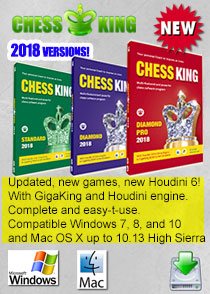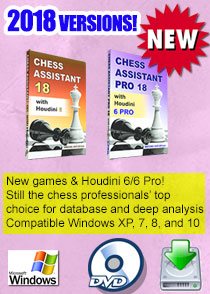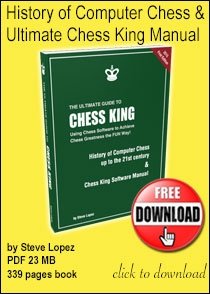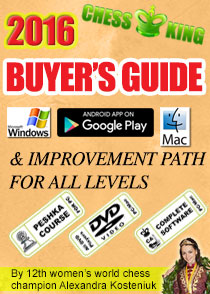Human Beings Getting Smarter Every Generation, Says Chess Study!
Chess blog for latest chess news and chess trivia (c) Alexandra Kosteniuk, 2012
Hi everyone,
Grandmaster Andy Soltis, writing in The New York Post, says several years ago, an Australian researcher, Robert W. Howard, studied how the chess ratings of top players escalated over decades — and he concluded that the entire world is just getting smarter. Ratings growth is preliminary evidence that “average human intelligence really is rising,” he wrote.

Ken Regan, an international master and associate professor of computer science at the University of Buffalo, has a more modest goal. He devised a new metric, Intrinsic Performance Rating (IPR), to measure the move quality of great players of the past using the Rybka program.
And, yes, we are getting better at this game. He found, for example, that one of Paul Morphy’s opponents in the first American championship played at a pitiful 1194 level — that is well below today’s average tournament player.
Other findings: When Howard Staunton won the 1843 match that made him unofficial world champion, he played at an 1899 level.
Bent Larsen managed only an IPR of 2187 when he was crushed by Bobby Fischer in a 1971 match.
Curiously, Regan found that Anatoly Karpov played 179 points better than Garry Kasparov did in their 1987 match — which was drawn. And Fischer played only seven points better than Boris Spassky did in their one-sided 1972 match.
From Alexandra Kosteniuk's
www.chessblog.com
Also see her personal blog at
www.chessqueen.com
Labels: andrew soltis, andy soltis, chess study
Fantastic new chess novel on the horizon - Los Voraces 2019
Chess blog for latest chess news and chess trivia (c) Alexandra Kosteniuk, 2011Hi everyone,
What makes a beautiful chess morning? Surely, some chess news from the literary world. This nice article in the Boston Globe set us for a chess mood this Monday. Harold Dondis and Patrick Wolff have written a nice review. Here it is:
Agatha Christie awake and return! You have a rival in the chess world, one Andrew Soltis, a premier columnist for Chess Life for many years, a NY Post chess columnist and author of many chess texts, and an accomplished tournament player. He has written a book, “Los Voraces 2019’’ (McFarland) or shall we say a chess satire wrapped in an engaging mystery that competes with the very best of whodunits.

“Los Voraces’’ concerns a tournament heavily endowed in the will of a deceased wealthy businessman that provides abundant and irresistible appearance fees and prizes for the greatest Grandmasters, who then play in the 2800 rated range. Los Voraces is a tiny town somewhere in New Mexico virtually cut off from civilization. The tycoon’s will provides funding that will attract the world’s greatest Grandmasters. The tournament must be private. It is held annually to host a collection of dedicated, in some cases narcissistic and omnipotent, achievers, including the world champion Grushevsky. They come from various nations and engulf this small town. The narrator receives excellent pay as arbiter of the tournament, and apparently as caretaker of the sometimes childish, venomous, and unmannered group of geniuses.
The arbiter manages pretty well until, prior to the commencement of the tourney, the Grandmaster Attila Gabor from Hungary falls to the floor with a fatal heart attack. The unpopular Gabor was not going to be missed by his contemporaries, and his death swelled the prize fund. No problem there, except the narrator seemed to find that odd pills had been substituted for Gabor’s heart medicine. The atmosphere turns acrid, as a groupie finds a coral snake in her purse and goes on to heaven. Then a Dutch Grandmaster expires as he seals a move for adjournment. The arbiter, nevertheless, keeps control of his flock, who are given to such eccentricities as agreeing to a draw the night before and then shaking hands at the tournament without making a move - a no-move draw.
The narrator not only reports on the progress of the tournament but also includes the chess games, including a draw in which eight queens appear on the board. It is best for the reader to postpone review of the games until finished with the narration, or else the mystery will take longer to read than “War and Peace.’’ Soltis’s descriptions of the players, their habits, their machinations, and the chess world are salted with wry prose, anecdotes, proverbs, and excellent quotes that make this a remarkable satire. He cites former world champion Tigran Petrosian as stating that every chess position has a weakness, even if it is imperceptible. Who can quarrel with that?
As for who killed these innocent people - no, we will not tell.
From Alexandra Kosteniuk's
www.chessblog.com
Also see her personal blog at
www.chessqueen.com
Labels: andrew soltis, chess fiction, chess literature, chess news, chess novel
Nice chess interview with Chess Hall of Fame inductee GM Andrew Soltis
Chess blog for latest chess news and chess trivia (c) Alexandra Kosteniuk, 2011
Hello everyone,
Here is a nice chess interview with GM Andrew (Andy) Soltis Interview by Jim Eade (U.S. Chess Trust president). GM Soltis was the new inductee - along with GM Boris Gulko - at the U.S. Chess Hall of Fame that (re)opened in Saint Louis recently.
"I don’t know when I was hooked, or why for that matter. Maybe it was for the reason Botvinnik gave: Some people like to think and chess is the best way to satisfy the urge." - GM Andy Soltis
Jim Eade: You were born in Hazelton, PA. in 1947. How did you learn to play chess?
GM Andrew (Andy) Soltis: I learned the moves from a book. I’ve forgotten the name but I had taken it out of the children’s section of the public library in the Astoria, Queens section of New York, where my family was living. I didn’t know anyone who played, much less anyone who could teach me, so for about four years chess remained one of many games I knew how to play but didn’t take seriously.
JE: How old were you, and who were your biggest influences?
AS: I must have been about 10 when I learned. Today that would put me about four years behind the curve for aspiring players. I never had a chess lesson, a teacher, coach or trainer. I remember when I read a Paul Keres column in Chess Life, in 1972, in which he said the way to become a strong player is to work with a strong instructor. He added that this must have been the way young masters of the day got strong. He named Karpov, Tukmakov, Huebner and several others _ including Soltis. I just smiled.
JE: When you first started, where could you play?
AS: I finally got to play around 1961 when there was a meeting, at the same Astoria library, of amateurs who wanted to start a chess club. They eventually rented quarters at a local church but the club only lasted a year or so. I also discovered that chess moves could be recorded and they appeared regularly in the New York Times, thanks to Hermann (cq) Helms. But I didn’t know what to make of, say, the opening moves of the Botvinnik-Tal world championship rematch. After all, why would anyone play 1 c4 to start a game? And what would possess his opponent to reply 1…g6 ?
JE: What was the organized chess scene like back when you first got involved?
AS: There wasn’t much of anything that could be called “organized.” The biggest events, by far, were the annual U.S. Championship, usually held around Christmastime at a midtown hotel, and the final Met League match, which was almost always a showdown between the Marshall and Manhattan clubs. I was a wallboard boy for a few games of one U.S. Championship and played regularly in the Met League, starting in the B division. My first big thrill was announcing a mate in eight moves, beginning with a rook sacrifice, against Bill Fredericks on first board in a Jamaica Chess Club-Marshall B team match. A few weeks later when Fischer spoke at the Marshall club, Carrie Marshall introduced me to Bobby and mentioned that game. “Eight moves?” he said. How could I give up chess after that?
Click Here to Read the Entire Interview >>
From Alexandra Kosteniuk's
Also see her personal blog at
Labels: andrew soltis, chess hall of fame, jim eade, US Chess Trust
|
|




































